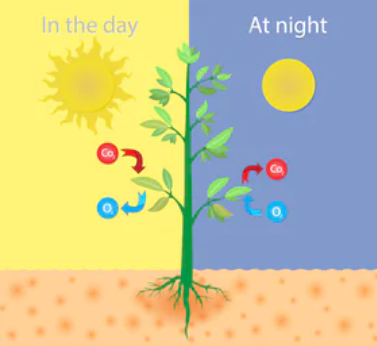
Compensation point is the value of the factor where there is-
a. Neither photosynthesis or respiration.
b. Little photosynthesis
c. Photosynthesis is equal to the rate of respiration
d. Beginning of photosynthesis.
Answer
501k+ views
Hint: The compensation point in the plant is the light intensity on the light curve for which the rate of photosynthesis is equal to the rate of respiration in the plant cell.
Complete answer:
> Option A, Neither photosynthesis or respiration
This option is incorrect as the compensation point is light intensity with the equal value of photosynthesis and respiration.
> Option B, Little photosynthesis
Option b is not the right answer to the question as the right value of the compensation point is the balance between the both photosynthesis and respiration.
> Option C, Photosynthesis is equal to the rate of respiration
Compensation point:
The compensation point is the value of light intensity on the light curve where the rate of photosynthesis exactly matches the rate of respiration. At this point, the uptake
Timing:
This point is reached during early mornings as well as late evenings. Respiration is relatively constant whereas photosynthesis depends on the amount of sunlight the plant is receiving.
Rate:
At the compensation point, the rate of photosynthesis should be balanced to the rate of respiration resulting in plant is neither consuming nor building biomass.
> Option D, Beginning of photosynthesis.
This is not right as the compensation point is made up of the balanced amount of both the process photosynthesis as well as respiration.
Hence, The correct answer is option (C).

Note: Compensation point varies in different species of plants. It even varies in response to changes in temperature and other environmental factors. Compensation points can usually be seen at dusk and dawn on a cloudy day.
Complete answer:
> Option A, Neither photosynthesis or respiration
This option is incorrect as the compensation point is light intensity with the equal value of photosynthesis and respiration.
> Option B, Little photosynthesis
Option b is not the right answer to the question as the right value of the compensation point is the balance between the both photosynthesis and respiration.
> Option C, Photosynthesis is equal to the rate of respiration
Compensation point:
The compensation point is the value of light intensity on the light curve where the rate of photosynthesis exactly matches the rate of respiration. At this point, the uptake
Timing:
This point is reached during early mornings as well as late evenings. Respiration is relatively constant whereas photosynthesis depends on the amount of sunlight the plant is receiving.
Rate:
At the compensation point, the rate of photosynthesis should be balanced to the rate of respiration resulting in plant is neither consuming nor building biomass.
> Option D, Beginning of photosynthesis.
This is not right as the compensation point is made up of the balanced amount of both the process photosynthesis as well as respiration.
Hence, The correct answer is option (C).

Note: Compensation point varies in different species of plants. It even varies in response to changes in temperature and other environmental factors. Compensation points can usually be seen at dusk and dawn on a cloudy day.
Latest Vedantu courses for you
Grade 11 Science PCM | CBSE | SCHOOL | English
CBSE (2025-26)
School Full course for CBSE students
₹41,848 per year
Recently Updated Pages
Master Class 11 Economics: Engaging Questions & Answers for Success

Master Class 11 Business Studies: Engaging Questions & Answers for Success

Master Class 11 Accountancy: Engaging Questions & Answers for Success

Master Class 11 English: Engaging Questions & Answers for Success

Master Class 11 Computer Science: Engaging Questions & Answers for Success

Master Class 11 Maths: Engaging Questions & Answers for Success

Trending doubts
State and prove Bernoullis theorem class 11 physics CBSE

1 ton equals to A 100 kg B 1000 kg C 10 kg D 10000 class 11 physics CBSE

State the laws of reflection of light

One Metric ton is equal to kg A 10000 B 1000 C 100 class 11 physics CBSE

Difference Between Prokaryotic Cells and Eukaryotic Cells

1 Quintal is equal to a 110 kg b 10 kg c 100kg d 1000 class 11 physics CBSE




